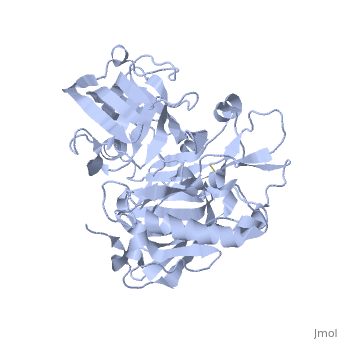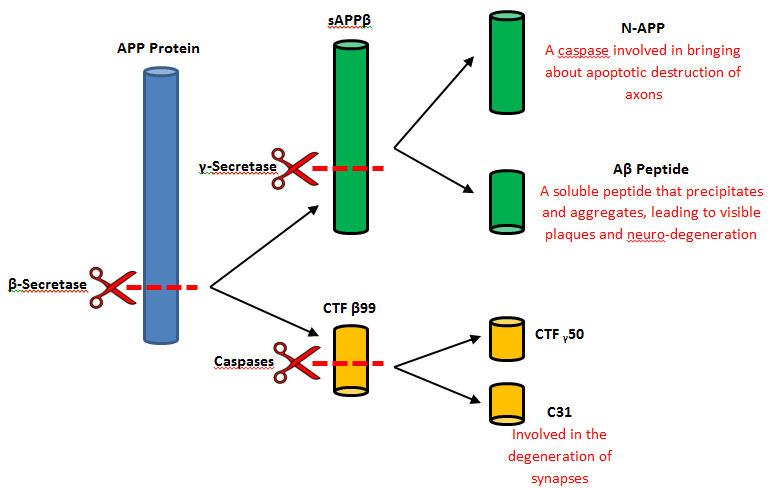Beta Secretase (BACE1) 1SGZ
From Proteopedia
| Line 23: | Line 23: | ||
</ref>. | </ref>. | ||
| - | The S3 pocket is adjacent to the Thr 232 and the amino acids from the 10s loop, which contains Glycine and Glutamine. The Glycine located in the 10s loop that the substrate forms a hydrogen bond with helps stabilize the 10s loop which further balances the interaction of the beta secretase-substrate. In an open conformation of the 10s loop, the substrate and the S3 pocket have a greater affinity to bind with each other | + | The S3 pocket is adjacent to the Thr 232 and the amino acids from the 10s loop, which contains Glycine and Glutamine. The Glycine located in the 10s loop that the substrate forms a hydrogen bond with helps stabilize the 10s loop which further balances the interaction of the beta secretase-substrate. In an open conformation of the 10s loop, the substrate and the S3 pocket have a greater affinity to bind with each other. The stabilization of the structure depends on the active site, flap and 10s loop <ref> Kumalo, M.; Soumendranath B.; Soliman, M. E. Investigation of Flap Flexibility of β-secretase Using Molecular Dynamic Simulations. Journal of Biomolecular Structure and Dynamics [Online] , 2015, 1-12. |
| + | http://www.tandfonline.com/doi/full/10.1080/07391102.2015.1064831</ref>. | ||
| - | Specifically, BACE-1 is a transmembrane aspartic protease which cleaves the amyloid-beta precursor protein and produces the amyloid-beta peptide. Two water molecules are in the process for the aspartic protease. The location of the first water molecule for BACE-1 is between the Asp 32 and Asp 228 (8).Once the substrate binds, the two aspartate residues form a hydrogen bond with the water molecule. Then, the water molecule becomes the nucleophile that attacks the carbonyl. The second water molecule forms a hydrogen bond with Tyr residue that is found in the flap. The behavior of the two water molecules affects the activity of BACE-1 ( | + | Specifically, BACE-1 is a transmembrane aspartic protease which cleaves the amyloid-beta precursor protein and produces the amyloid-beta peptide. Two water molecules are in the process for the aspartic protease. The location of the first water molecule for BACE-1 is between the Asp 32 and Asp 228 (8).Once the substrate binds, the two aspartate residues form a hydrogen bond with the water molecule. Then, the water molecule becomes the nucleophile that attacks the carbonyl. The second water molecule forms a hydrogen bond with Tyr residue that is found in the flap. The behavior of the two water molecules affects the activity of BACE-1 <ref name="seven">Shimizu, H.; Tosaki, A.; Kaneko, K.; Hisano, T.; Sakurai, T.; Nukina, N. Crystal Structure of an Active Form of BACE1, an Enzyme Responsible for Amyloid Beta Protein Production. Molecular and Cellular Biology [Online] 2008, 28(11), 3663-671. |
| + | http://mcb.asm.org/content/28/11/3663.full.pdf+html | ||
| + | </ref>. | ||
== Structural Highlights == | == Structural Highlights == | ||
Revision as of 02:23, 13 April 2016
Beta-secretase, also known as BACE or Memapsin 2, is encoded by the gene BACE1. Beta-secretase is a proteolytic, transmembrane enzyme with two active sites on the extracellular region. It is associated with processing amyloid precursor protein (APP), which is an integral membrane protein.[1] A malfunction in the processing of APP results in the formation of the peptide amyloid beta. Amyloid-beta is a neurotoxic peptide segment that aggregates into plaques. These plaques are the primary component of plaques found in individuals with Alzheimers Disease. [2] Other biological associations of this enzyme include modulating myelination in the central and peripheral nervous systems.[3]
Enzyme Class
Beta-secretase is an enzyme that is classified as a class 3 enzyme, which are hydrolases [4]. The enzyme acts on breaking peptide bonds and therefore is also considered a peptidase and belongs to the subclass of aspartic acid endopeptidases.[5]
Structure
| |||||||||||
References
- ↑ Ghosh, A.; Kumaragurubaran, N.; Hong, L.; Koelsh, G.; Tang, J. Memapsin 2 (Beta-Secretase) Inhibitors: Drug Development. CAR Current Alzheimer Research. [Online] 2008, 5, 121–131. http://jamesmadisonva.library.ingentaconnect.com/content/ben/car/2008/00000005/00000002/art00004
- ↑ John, V.; Beck, J. P.; Bienkowski, M. J.; Sinha, S.; Heinrikson, R. L. Human β-Secretase (BACE) And BACE Inhibitors. ChemInform. [Online] 2004, 35, 4625-4630. http://pubs.acs.org/doi/pdf/10.1021/jm030247h
- ↑ Hu, X.; Hicks, C. W.; He, W.; Wong, P.; Macklin, W. B.; Trapp, B. D.; Yan, R. Bace1 Modulates Myelination in the Central and Peripheral Nervous System. Nature Neuroscience Nat Neurosci. [Online] 2006, 9, 1520–1525. http://www.nature.com/neuro/journal/v9/n12/abs/nn1797.html
- ↑ Nomenclature Committee of the International Union of Biochemistry and Molecular Biology. The Enzyme List Class 3 — Hydrolases. http://www.enzyme-database.org/downloads/ec3.pdf
- ↑ DBGET Search. KEGG ENZYME: 3.4.23.46. http://www.genome.jp/dbget-bin/www_bget?ec:3.4.23.46
- ↑ 6.0 6.1 Venugopal, C.; Demos, C. M.; Rao, K. S. J.; Pappolla, M. A.; Sambamurti, K. Beta-secretase: Structure, Function, and Evolution. CNS & Neurological Disorders Drug Targets. [Online] 2008. 7(3), 278–294. http://www.ncbi.nlm.nih.gov/pmc/articles/PMC2921875/
- ↑ 7.0 7.1 7.2 Shimizu, H.; Tosaki, A.; Kaneko, K.; Hisano, T.; Sakurai, T.; Nukina, N. Crystal Structure of an Active Form of BACE1, an Enzyme Responsible for Amyloid Beta Protein Production. Molecular and Cellular Biology [Online] 2008, 28(11), 3663-671. http://mcb.asm.org/content/28/11/3663.full.pdf+html
- ↑ Kumalo, M.; Soumendranath B.; Soliman, M. E. Investigation of Flap Flexibility of β-secretase Using Molecular Dynamic Simulations. Journal of Biomolecular Structure and Dynamics [Online] , 2015, 1-12. http://www.tandfonline.com/doi/full/10.1080/07391102.2015.1064831



